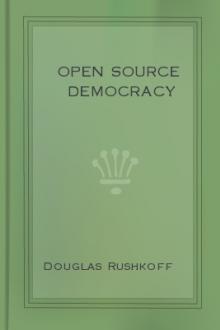The Emma Gees, Herbert Wes McBride [best books to read TXT] 📗

- Author: Herbert Wes McBride
Book online «The Emma Gees, Herbert Wes McBride [best books to read TXT] 📗». Author Herbert Wes McBride
[Illustration: German Aeroplane Trophy--Jules Vedrine Examining the Machine Gun]
Shortly after this, when back in reserve, we watched another fight directly over our heads. This was a pitiful tragedy. One of England's best and most famous flyers, Captain Saunders, had been over the German lines and had engaged and brought down an enemy and then, having exhausted his ammunition, started back "home" for more, but encountered a fast-flying boche who immediately attacked him. Being unable to return the fire, he tried every trick known to the birdman to escape but without avail. He came lower and lower in his evolutions and finally settled into a wide and sweeping spiral. The boche did not come very low as several machine guns and "Archies" opened on him. The other plane came slowly down in its perfect spiral course and, noticing that the engine was not running, we thought the aviator was intending to make a landing in a large open field toward which he was descending, but when the spiral continued until the tip of one wing touched the ground and crumpled up we knew there was something wrong and ran to the spot, not more than one hundred yards from where we were standing. We got the Captain out and found that he had been shot in the head but was still conscious. He died within a short time.
Other of our aviators who had witnessed his first fight furnished the beginning of the story and we could see that in the second engagement he never fired a shot, and every one of his magazines was empty. I examined them myself.
The large, sausage-shaped observation balloons sometimes afford a little diversion. When we were at Dranoutre one of them used to hang over our billeting place. One day an enterprising Hun came flying across and endeavored to attack it but was driven off by two of our planes.
Again, one of our balloons broke away in a strong wind and started toward Germany. Both the occupants of the basket made safe parachute descents with all their instruments and papers, but the balloon sailed swiftly away. Then the Germans opened on it with every gun in that sector. I feel sure that they fired at least two thousand shots at it. The air around was so filled with the smoke of shell-bursts that it was sometimes difficult to discern the balloon itself. It was late in the evening and the last we saw of the "sausage" it was still traveling eastward, apparently unhit. The joke of the whole thing is that the balloon was never hit and, the wind veering during the night, it returned and came down inside our lines within a few miles of its starting place.
On two occasions Zeppelins came over our lines, evidently returning from raids across the Channel. One time it was night and we could only hear, but not see the air-ship. The other time, during the St. Eloi fight, I saw one, just at daybreak. It was in plain sight but well over the German lines and headed east. No attempt was made to do any bombing of our positions by the Zeppelins although we occasionally received visits from bombing airplanes. The night before I left France, the last time, they dropped several bombs on the village of Ecoviers where I was staying. The only result was the killing of two civilians, the wounding of several others and the wrecking of one of the few whole houses in the town which had often been a victim of shells. Not a soldier was injured.
You have, no doubt, read of cases where bombs have been dropped on or near hospitals, ambulances and so on, and possibly you think that this was intentional on the part of the boche. If so you flatter him. This bomb dropping is, at best, very uncertain business and it would be well-nigh impossible for the most expert flyer to aim at and hit any single building. The fact is that, in nearly every town and city behind the lines, hospitals, ammunition stores and billets are located in close proximity to one another, with probably a railway running near by, so that any attempt to bomb the really important "military" points will necessarily jeopardize the homes of non-combatants--including hospitals. Even the Zeppelins, which are much more stable than an airplane, have never been able to place their bombs with any degree of accuracy.
CHAPTER XIII (THE BATTLE OF ST. ELOI)
No one realizes better than I the utter futility of attempting to describe a modern battle so that the reader can really understand or visualize it. There are no words in any vocabulary that convey the emotions and thoughts of persons during the long days and nights of horror--of the continual crash of the shells, the melting away or total annihilation of parapets and dug-outs; being buried and spattered with mud and blood; with dead and wounded everywhere and, worst of all, the pitiful ravings of those whose nerves have suddenly given way from shell shock. No imagination can grasp it; no picture can more than suggest a small part of it. None who has not had the actual experience can ever understand it. The hospital and ambulance people back at the rear see some of the results, but even they can have no conception of what it is like to be actually in the torment and hell-fire at the front.
I could not, if I so desired, give an accurate description of the operations in general. I have not the necessary data as to the various troops engaged or local results accomplished. Historians will record all that. My field of description is limited to my field of personal observation, which was not very extensive. I suppose, however, that I saw as much as it was possible for any one person to see, so I shall try to describe that part of the battle of St. Eloi in which it was my fortune to participate.
At the point at the southern end of the Ypres salient, where the line turns sharply to the eastward, stood the village of St. Eloi. It consisted of perhaps fifteen or twenty buildings of the substantial brick and iron construction characteristic of all Flemish towns and was situated at the intersection of the two main roads paved with granite blocks, one running to Ypres and the other through Voormezeele. The village itself, except for two or three outlying buildings, was inside our lines. The portion held by the enemy, however, included a prominent eminence, called the "Mound," which dominated our whole line for a mile or more. This mound had been a bone of contention for more than a year and several desperate attempts had been made to take it; notably in February and in March, 1915, when the Princess Pat's were so terribly cut up and lost their first Commanding Officer, Colonel Farquhar. All these attempts having failed, our engineers proceeded to drive tunnels and lay mines, six in number, so as to cut off the point of the German salient for a distance of about six hundred yards.
All was completed; mines loaded and ready, and the time for the attack was fixed for daybreak of the twenty-seventh of March. The mines were to be fired simultaneously, followed immediately by an attack, in force, by the Royal Fusiliers, the Northumberland Fusiliers and a battalion of the West Yorkshires. Our brigade (Fourth Canadian) was immediately to the right of the point of attack, but, as the Imperial troops had changed their machine guns for the lighter Lewis automatic rifles to be used with the advancing troops, it was deemed advisable to bring up all available machine guns of the heavier types to support the advance and to resist the inevitable counter-attacks. These guns, twelve in number, were placed at advantageous positions on the flanks of the attacking troops. I was only a sergeant at that time, but, having been an officer, and having had more actual experience in machine-gun work than the others, the direct supervision of these guns was entrusted to me.
ELOI MAPThe map on the opposite page is known as St. Eloi map. It is particularly interesting as showing, very faintly, a great group of mine craters within the British lines. No. 1 can be seen in the lower left section just above the horizontal fold in the map and to the left of the perpendicular. Here the British line comes in at the lower left corner, where it almost immediately branches, passing through figures 44 and 77, joining the main line again at the left and below Shelley Farm. Within this loop are the six enormous mine craters. No. 2 is immediately to the right of figure 96, while 3, 4 and 5 are in a line with it just to the right of the perpendicular fold. The faint dotted line that comes to an apex just below St. Eloi is the British trench known as Queen Victoria Street. This map is made from air photographs dated March 5th, 1916.
[Illustration: St. Eloi Map]
We got all the guns up and in place during the night of the twenty-sixth. In addition, our people brought up a great many trench mortars of different calibers, with enormous quantities of ammunition. We then sat down to wait for the "zero" hour, meaning the time for the show to begin. I took my position at our extreme left, as I wanted to be where I could see everything.
Promptly at the appointed time, the mines were fired and then ensued the most appallingly magnificent sight I have ever witnessed. There was little noise but the very earth appeared to writhe and tremble in agony. Then, slowly, it seemed in the dim light, the ground heaved up and up until, finally, bursting all bonds, earth, trees, buildings, trenches and men went skyward. Immediately followed great clouds of flaming gas, expanding and growing like gigantic red roses suddenly bursting into full bloom. It was an earthquake, followed by a volcanic eruption.
Before the flying debris had reached the ground the Fusiliers were over the top, fighting their way through the jungles of wire and shell craters. The occupation of the mine craters themselves was, of course, unopposed as there was no one there to offer opposition. They kept on, however, meeting the German reinforcements coming up from the rear, fighting them to a standstill and establishing themselves beyond the Mound.
Then all hell broke loose. From





Comments (0)